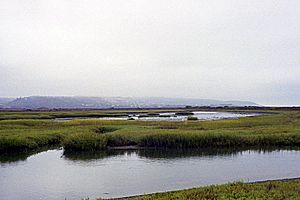Tijuana River Estuary facts for kids
Quick facts for kids Tijuana River Estuary |
|
|---|---|

Tijuana River Estuary
|
|
| Lua error in Module:Location_map at line 420: attempt to index field 'wikibase' (a nil value). | |
| Location | San Diego County, California |
| Area | 1,569 acres (635 ha) |
| Designated | 1973 |
The Tijuana River Estuary is a very important natural area. It's a coastal wetland where the Tijuana River meets the ocean. This special place is in San Diego County, California. It's right next to Tijuana, Baja California, in Mexico.
An estuary is a shallow water habitat. It's where fresh water from a river mixes with salty ocean water. The Tijuana River Estuary is sometimes called an intermittent estuary. This means its water level changes a lot. Sometimes it's very wet, and other times parts of it can be dry. In 1973, it was named a National Natural Landmark. This shows how important it is.
Amazing Wildlife Habitat
The Tijuana River Estuary is one of the last remaining salt marsh areas on the South Coast of California. Salt marshes are wetlands that are flooded by ocean tides. They are very important for many animals.
This estuary is located right under the Pacific Flyway. This is like a superhighway in the sky for birds. Many migratory birds use the estuary as a stopover point. They rest, feed, and nest here during their long journeys.
A Large Natural Area
The Tijuana River Estuary is the biggest natural coastal area left. It stretches between Santa Barbara, California and San Quintín, Baja California. This huge area covers about 2,500 acres. That's three times the size of Central Park in New York City!
Many different kinds of animals and plants live here. Both birds that travel long distances and animals that live here all the time depend on the estuary. It's a vital place for them to breed, find food, and build their homes. The estuary is located in the southern part of San Diego County. It's within the city limits of Imperial Beach.
Protecting the Land
For many years, the land in the estuary faced challenges. Before 1994, a lot of people walking through the area caused the topsoil to wear away. This is called soil erosion. After 1994, vehicles used for patrolling the border also caused a lot of soil loss.
To help fix this problem, a big effort started in 2010. People began to replant the area along the border system. This re-vegetation helps to hold the soil in place. It also makes the habitat better for the plants and animals that live there.

